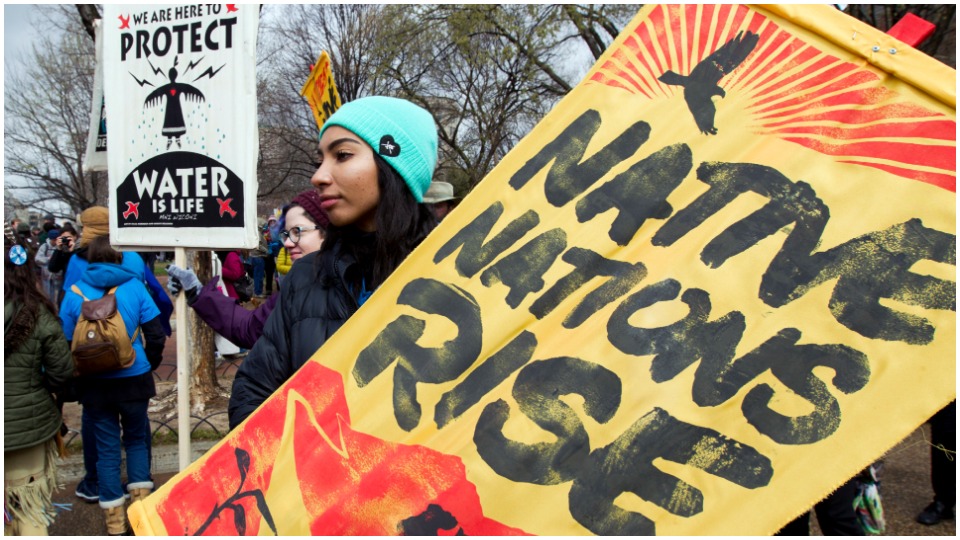
WASHINGTON—In a big win for Native Americans and their environmental allies, U.S. District Judge James Boasberg in D.C. ordered the controversial Dakota Access Pipeline to shut down within 30 days. If upheld, his order could close it for at least 13 months.
Boasberg ruled the pipeline’s owner, Energy Transfer Partners, and its federal backer, the Trump administration’s Army Corps of Engineers, need to do a full Environmental Impact Statement on the pipeline’s effect on Lake Oahe in particular as well as the Missouri River and other water sources. The corps didn’t do that, he said, on July 6.
“Today is a historic day for the Standing Rock Sioux Tribe and the many people who have supported us in the fight against the pipeline,” Standing Rock Sioux Tribal Chairman Mike Faith said in a statement.
“This pipeline should have never been built here. We told them that from the beginning.”

Boasberg vacated the Dakota Access Pipeline’s operating permit and ordered it shut down until the full EIS is done. But he didn’t order Dakota Access (DAPL) ripped out of the ground, an option at least one tribal leader advocated. That could cause even more environmental damage, the judge noted.
The lake is the prime source of drinking water for the four Sioux Nations, who have been campaigning against the project for years. Not only does the controversial DAPL endanger their water, it passes through sacred burial grounds, the Sioux add.
Tens of thousands of gallons of oil are already flowing through the pipeline, and both the pipeline’s sponsor and Trump want to keep it flowing. So do U.S. building trades unions, who see pipeline construction as a source of construction and operating jobs.
Boasberg’s ruling upset the Laborers in particular, and union President Terry O’Sullivan said he’s confident higher courts will reinstate the pipeline’s operating permit. “The decision second-guesses the rigorous permitting and approval process, which guided the Dakota Access Pipeline as well as that of thousands of crucial infrastructure projects across the country,” O’Sullivan said following the decision’s release. “The ruling also ignores the high standards and reputation for quality of the more than 8,000 skilled building trades men and women who built Dakota Access using the safest and most advanced construction methods,” he claimed.
The tribes were particularly upset at the threat a large oil spill poses to their drinking water. That’s what happened when another controversial pipeline, Keystone, sprang a leak last November and gushed almost 400,000 gallons of oil.
“This is what pipelines do: They spill,” Chase Iron Eyes, lead counsel for the Lakota People’s Law Project and public relations director for Oglala Sioux Tribe President Julian Bear Runner, told Native News Online then.
“This latest Keystone leak demonstrates why we stood against Dakota Access in the first place, why we’re doing so again now, and why we’re prepared to fight Keystone XL every step of the way.”
“Dakota Access has already spilled 11 times, and now they want to double its capacity. That pipeline should be pulled out of the ground, and KXL should be stopped as well,” Standing Rock Sioux Chairman Mike Faith said then.
The Corps of Engineers argued that a lesser-detailed environmental review, called an Environmental Assessment, was enough to justify the pipeline’s construction. It also conceded a full Environmental Impact Statement could take anywhere from 13 months to three and a half years.
Boasberg said the corps blew it, and must do the full EIS.
The National Environmental Policy Act, he said, requires a full-fledged EIS if one of three factors are met. One factor was the project could have a large impact—something that was obvious from the thousands of gallons of oil it now carries.
Another is that it’s publicly controversial, which was obvious from past protests against the pipeline, including a sit-in that lasted for months in 2016-17. Boasberg also noted the tribal opposition to the pipeline and their contentions that the Corps didn’t follow environmental and other laws requiring consultation with Native Americans concerning projects on their lands.
“Lake Oahe is a large reservoir lying behind a dam on the Missouri River and stretching between North and South Dakota,” the judge wrote. “Fearing severe environmental consequences, American Indian Tribes on nearby reservations have sought for several years to invalidate federal permits allowing the Dakota Access Pipeline to carry oil under the lake. Today, they finally achieve that goal—at least for the time being.”
“Following multiple twists and turns in this long-running litigation, this court found defendant U.S. Army Corps of Engineers violated the National Environmental Policy Act when it granted an easement to Defendant-Intervenor Dakota Access, LLC to construct and operate a segment of that crude-oil pipeline running beneath the lake.”
“The Corps failed to produce an Environmental Impact Statement despite conditions that triggered such a requirement. The court consequently remanded the case to the agency to prepare such an EIS.” But Boasberg also asked the two sides what to do in the meantime.

“In other words, the court asked” if the operating permit, an easement, “should be vacated and the pipeline emptied during the remand process. Although mindful of the disruption such a shutdown will cause, the court now concludes the answer is ‘yes.’”
“Clear precedent favoring” vacating the permit and the easement while the EIS is done, “coupled with the seriousness of the Corps’ deficiencies outweighs the negative effects of halting the oil flow for the 13 months the Corps believes the creation of an EIS will take.”
Trump has also tried to fast-track pipelines, including Dakota Access, and other construction projects nationwide, through an executive order telling federal agencies to override and dismiss environmental concerns.
But on April 16, another federal judge bounced a key part of Trump’s order, called Nationwide Permit 12, that the Oval Office occupant wanted pipeline and other project sponsors to use so as to avoid addressing environmental impacts.
That decision, in a lawsuit by the Natural Resources Defense Council, blocked the permit for a pumping station on Keystone XL, which was built under a Project Labor Agreement involving six construction unions, including the Laborers, the Teamsters, and the Operating Engineers.
Like free stuff? So do we. Here at People’s World, we believe strongly in the mission of keeping the labor and democratic movements informed so they are prepared for the struggle. But we need your help. While our content is free for readers (something we are proud of) it takes money — a lot of it — to produce and cover the stories you see in our pages. Only you, our readers and supporters, can keep us going. Only you can make sure we keep the news that matters free of paywalls and advertisements. If you enjoy reading People’s World and the stories we bring you, support our work by becoming a $5 monthly sustainer today.










